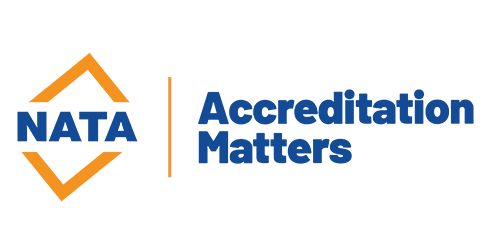
National Association of Testing Authorities, Australia
Scope of Accreditation
National Measurement Institute - Chemical and Biological Services
Site
Chemical Reference Materials
Accreditation No.
198
Site No.
14214
Date of Accreditation
19 Jan 2000
Contact
Dr Stephen Davies P: +61 (02) 94490183
Availability
Services available to external clients
Scope of Accreditation
Chemical Reference Materials
ISO 17034 (2016)
- The uncertainty of measurement is reported as an expanded uncertainty having a level of confidence of 95% unless stated otherwise
Calibration
| Service | Product | Determinant | Technique | Procedure | Limitations | |||||||||||||||||||||||||||||||||||||||||||||||||||||||||||||||||||||||||||||||||||||||||||||||||||||||||||||||||||||||||||||||||||||
|---|---|---|---|---|---|---|---|---|---|---|---|---|---|---|---|---|---|---|---|---|---|---|---|---|---|---|---|---|---|---|---|---|---|---|---|---|---|---|---|---|---|---|---|---|---|---|---|---|---|---|---|---|---|---|---|---|---|---|---|---|---|---|---|---|---|---|---|---|---|---|---|---|---|---|---|---|---|---|---|---|---|---|---|---|---|---|---|---|---|---|---|---|---|---|---|---|---|---|---|---|---|---|---|---|---|---|---|---|---|---|---|---|---|---|---|---|---|---|---|---|---|---|---|---|---|---|---|---|---|---|---|---|---|---|---|---|---|---|
| Pure organic certified reference materials | Agrichemicals | Fungicides; Herbicides; Insecticides | Mass balance; Quantitative Nuclear magnetic resonance (qNMR) | Reference Materials Producers Quality Manual | Pure organic compounds within the molecular weight range 70 - 900 g/mol | |||||||||||||||||||||||||||||||||||||||||||||||||||||||||||||||||||||||||||||||||||||||||||||||||||||||||||||||||||||||||||||||||||||
Capability With property value capability of -Purity from 80% - 100% Range of uncertainties: 0.3 to 2.5% for molecular weights between 70 to 500 g/mol 0.5 to 2.5% for molecular weights between 501 and 900 g/mol Covers compounds that are amendable to the mass balance and/or qNMR approach. This includes but is not limited Fungicides; Herbicides and Insecticides; their metabolites, degradation products and isotopically labelled analogues | ||||||||||||||||||||||||||||||||||||||||||||||||||||||||||||||||||||||||||||||||||||||||||||||||||||||||||||||||||||||||||||||||||||||||||
| Forensic drugs | 1-Phenyl-2-aminobutanes and related compounds; Amphetamines and related compounds; Butiophenones (α-alkylamino) and related substances; Cathinones (α-aminopropiophenones); Cocaine, metabolites and related compounds; Ephedrine and related substances; Miscellaneous compounds; Opiates and related substances; Pentiophenones (α-alkylamino) and related substances; Phenethylamines and related compounds; Synthetic cannabinoids | Mass balance; Quantitative Nuclear magnetic resonance (qNMR) | Reference Materials Producers Quality Manual | Pure organic compounds within the molecular weight range 70 - 500 g/mol | ||||||||||||||||||||||||||||||||||||||||||||||||||||||||||||||||||||||||||||||||||||||||||||||||||||||||||||||||||||||||||||||||||||||
Capability With property value capability of -Purity from 70% to 100% Range of uncertainties: 0.3 to 2.5 % for molecular weights between 70 to 500 g/mol 0.5 to 2.5 % for molecular weights between 501 to 900 g/mol Supported by CIPM Key Comparisons CCQM-K55a, b, c and d and CCQM-K104 Covers compounds that are amenable to the mass balance and/or qNMR approach. This includes but is not limited to Cathinones (α-aminopropiophenones); Cocaine including metabolites and related compounds; Ephedrine and related substances; Opiates and related substances; Phenethylamines and related compounds; Synthetic cannabinoids | ||||||||||||||||||||||||||||||||||||||||||||||||||||||||||||||||||||||||||||||||||||||||||||||||||||||||||||||||||||||||||||||||||||||||||
| Sport doping control references | Growth promotants and metabolites; Hormone antagonists and modulators; Phosphodiesterase-5 (PDE5) inhibitors; Prohormones and metabolites; Stimulants; Synthetic cannabinoids; Synthetic steroids and metabolites; Testosterone and metabolites | Mass balance; Quantitative Nuclear magnetic resonance (qNMR) | Reference Materials Producers Quality Manual | Pure organic compounds within the molecular weight range 70 - 900 g/mol | ||||||||||||||||||||||||||||||||||||||||||||||||||||||||||||||||||||||||||||||||||||||||||||||||||||||||||||||||||||||||||||||||||||||
Capability With property value capability of -Purity from 80% to 100% Range of uncertainties: 0.3 to 2.5% for molecular weights from 70 to 500 g/mol 0.5 to 2.5% for molecular weights from 501 to 900 g/mol Supported by CIPM Key Comparisons CCQM-K55a, b, c and d and CCQM-K104 Covers compounds that are amenable to the the mass balance and/or qNMR approach. This includes but is not limited to Non-peptide Growth Promotants and metabolites; Non-peptide Hormone Antagonists and Modulators; Pro-hormones and metabolites; Stimulants; Synthetic Cannabinoids; Synthetic Steroids and metabolites; Testosterone and metabolites; Degradation Products and Isotopically Labelled Analogues | ||||||||||||||||||||||||||||||||||||||||||||||||||||||||||||||||||||||||||||||||||||||||||||||||||||||||||||||||||||||||||||||||||||||||||
| Veterinary drugs | Antibiotics and key metabolites; Key metabolites and surrogates; Veterinary steroids | Mass balance; Quantitative Nuclear magnetic resonance (qNMR) | Reference Material Producers Quality Manual | Pure organic compounds within the molecular weight range of 70 to 500 g/mol | ||||||||||||||||||||||||||||||||||||||||||||||||||||||||||||||||||||||||||||||||||||||||||||||||||||||||||||||||||||||||||||||||||||||
Capability With property value capability of -Purity from 80% to 100% Range of uncertainties: 0.3 to 2.5% for molecular weights between 70 to 500 g/mol 0.5 to 2.5% for molecular weights between 501 to 900 g/mol Supported by CIPM Key Comparisons CCQM-K55a, b, c and d and and CCQM-K104 Covers compounds that are amendable to the mas balance and/or qNMR approach. This includes but is not limited to Antibiotics and Veterinary steroids including key metabolites and surrogates, degradation products and isotopically labelled analogues | ||||||||||||||||||||||||||||||||||||||||||||||||||||||||||||||||||||||||||||||||||||||||||||||||||||||||||||||||||||||||||||||||||||||||||
| qNMR standards | 1,4-Bis(trimethylsilyl)-benzene; 2,6-Di-tery-butyl-4-methylphenol; Dimethyl fumarate; Dimethyl sulfone; Dimethyl terephthalate; Glycine; Hydroquinone; Maleic acid; Potassium hydrogen maleate; Sodium acetate; Trioxane; Triphenylphosphine oxide | Mass balance; Quantitative Nuclear magnetic resonance (qNMR) | ||||||||||||||||||||||||||||||||||||||||||||||||||||||||||||||||||||||||||||||||||||||||||||||||||||||||||||||||||||||||||||||||||||||||
Capability With a Property Value Capability of -
| ||||||||||||||||||||||||||||||||||||||||||||||||||||||||||||||||||||||||||||||||||||||||||||||||||||||||||||||||||||||||||||||||||||||||||
The only data displayed is that deemed relevant and necessary for the clear description of the activities and services covered by the scope of accreditation.
Grey text appearing in a SoA is additional freetext providing further refinement or information on the data in the preceding line entry.
Accreditation No.
198
Site No.
14214
Print date
01 Jan 2026
END OF SCOPE